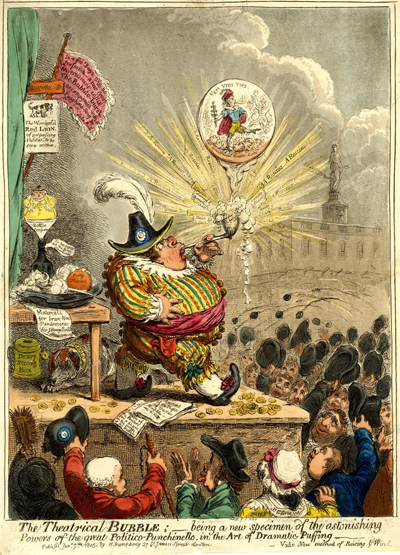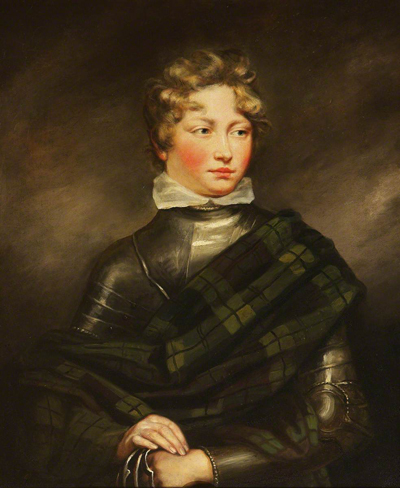The Theatrical Bubble. . .
This print provides a satiric look at Richard Brinsley Sheridan, playwright, politician, and principal owner/manager of the Drury Lane Theatre, and the "powers" and methods he was willing to use to "raise the wind," i.e. procure money to keep himself and his theatre afloat.
Like many caricatures, this print starts with a visual/verbal pun. Sheridan IS a himself a "Theatrical Bubble," thoroughly inflated and rotund in shape, appearing as Punchinello, the scheming and self-serving character from the Commedia del Arte. But at the same time he is also CREATING a "Theatrical Bubble" by puffing (extravagantly praising) the 13 year old child actor, William (Master) Betty, whose performances had so captivated audiences that he was routinely dubbed as "young Roscius" referring to the famous Roman actor, Quintus Roscius, considered a classical paragon of dramatic ability.

© Trustees of the British Museum
Sheridan was famously extravagant, going in and out of debt numerous times during the course of his life, but often saved by a potent combination of wit, ingenuity, and his own remarkable persuasive powers. In 1805, the Theatre Royal at Drury Lane was a huge theater, seating around 3600, and was, of course, hugely expensive to maintain. So Sheridan and his staff needed to stage theatrical productions that were popular with a wide range of patrons from aristocrats to chimnery sweeps including a steady diet of farces, a regular rotation of laughing comedies like his own plays, operatic spectacles that could take advantage of the size and technical facilities of the space, or as in this case, capitalize on a current fad or fashion, to ensure that seats were filled night after night and the guineas seen at his feet kept on coming.
While Apollo looks down disapprovingly from the top of the Drury Lane Theater shown in the background, Gillray alludes to some of these lamentable shifts below and atop the table behind Sheridan. The dog labeled "Carlo," for instance refers to The Caravan; or, The Driver and His Dog, a Grand Serio-Comic Romance by Frederic Reynolds, first performed at Drury Lane on 5 December, 1803 in which Carlo, the acting dog, a fan favorite, played a major role. A large bubble on the table is labeled The Forty Thieves referring to the grand opera starring the beautiful Mlle Parisot, planned for the next season, which Gillray must have heard rumors about even before it reached the newspapers.
It is reported that in scenery, decorations, and dresses, etc. the Forty Thieves will very far exceed anything that has ever appeared on the British Stage. The expence in preparing it incurred heretofore, is said to exceed £6000. (Morning Chronicle. July 20, 1805)
A note below the soap mixture on the table suggests there are more bubbles where that came from: "Materials for bran-New pantomimes for Johnny's amusement," i.e. John Bull, the British public. And as a last resort, there was always the "The Bottle Conjuror" trick which alludes to a a real hoax perpetrated at the Haymarket theatre in 1749 when, in response to numerous advertisements placed by anonymous pranksters, a crowd of paying customers filled the theatre awaiting a special performance in which an acrobat/magician, it was claimed, would successfully conjure himself into a wine bottle in front of the entire audience. Needless to say, nothing was demonstrated that evening except the extreme gullibility of its patrons.
The primary focus of the print is the bubble created by Sheridan surrounding the young William Betty. As it happened, Betty was first inspired to act in 1803 at the age of 11 by seeing a production of one of Sheridan's plays, Pizarro, in Belfast. Betty seems to have had a natural gift for tone and gesture and a nearly photographic memory for lines, so it was not long before he began appearing to great applause in theaters in Belfast and Dublin in roles such as Osman in Voltaire's Zair, Young Norval in John Home's Douglas, and the title roles in James Thomson's Tancred and Shakespeare's Hamlet. Gillray shows him as young Norval trampling over the heads of some of the England's greatest actors, David Garrick, John Phillip Kemble, and George Frederick Cooke.

Master Betty as Young Norval
[1804]
© National Trust Attingham Park
By the time he appeared in London, after a tour of Scottish and provincial theatres in Glasgow, Edinburgh, Birmingham, Sheffield, Liverpool, Chester, and Manchester, Betty had already added the title role in Richard III, and Selim in Dr. John Brown's Barbarossa to the growing list of parts he could play, and had become a genuine celebrity.
Because of his ability as a dramatist to impersonate characters, Sheridan was often suspected of "puffing" his own productions in anonymous letters to the editors of the major newspapers. And there is such a letter by "Philo Roscius" addressed to the editor of The Courier on December 11th, the day after young Roscius appeared for the first time at Drury Lane which is a point for point response to a mild critique of the young actor who had appeared the previous week at Covent Garden. The quality of the writing and argumentation, and the knowledge it displays of the craft of acting, make it almost certainly by Sheridan.
But in this case, Sheridan didn't have to puff very hard. The Monthly Mirror for December 1, 1804 lists seven different publications about young Betty already for sale in November, including several biographical and critical accounts of his life and roles, as well as print portraits of him in character. Nonetheless, Sheridan left no stone unturned. During the ten days after young Roscius arrived in London, but before he appeared at Drury Lane, Sheridan made sure to have ads running in several papers to announce the upcoming engagement at Drury Lane. And as the London Star noted on December 5
Mr. Sheridan has given special directions that in every part [young Roscius] performs he shall be assisted by the utmost strength of the company, and that nothing shall be wanting which can tend to add to the impresssion and interest this extraordinary youth is calculated to produce.
Alas for Master Betty, his popularity was, in fact, a bubble. In 1808, he quit the stage to attend Cambridge University, and all his attempts at a comeback thereafter failed, defeated by comparisons with his former self.
Sources and Reading
- Commentary from the British Museum on The Theatrical Bubble. . ..
- "Richard Brinsley Sheridan" Wikipedia
- "Quintus Roscius Gallus," Wikipedia
- "Master Betty," Wikipedia
- "Pulcinella," Wikipedia
- "Theatre Royal, Drury Lane," Wikipedia
- "The Bottle Conjuror," Wikipedia "The Theatre Royal: Management," British History Online
- Thomas Wright and R.H. Evans, Historical and Descriptive Account of the Caricatures of James Gillray #532.
- Thomas Wright and Joseph Grego, The Works of James Gillray, the Caricaturist; With the History of His Life and Times, p. 324.
Comments & Corrections
NOTE: Comments and/or corrections are always appreciated. To make that easier, I have included a form below that you can use. I promise never to share any of the info provided without your express permission.